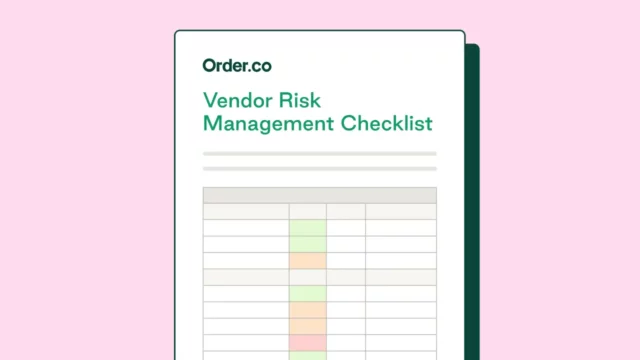How Poor Vendor Data Management Increases Operational Risk—and the Controls to Fix It

How Poor Vendor Data Management Increases Operational Risk—and the Controls to Fix It
Incomplete, inaccurate, and disorganized vendor data is more than a simple administrative headache. For finance, operations, and compliance leaders, it's a significant source of operational risk that silently undermines financial controls, regulatory adherence, and supply chain stability. Every outdated bank account number, duplicate supplier entry, or unverified tax ID represents a potential point of failure—one that can lead to misdirected payments, compliance penalties, or costly operational disruptions.
Without a systematic approach to managing supplier information, businesses are left vulnerable to everything from invoice fraud to production delays. The good news is that these risks are manageable. By implementing robust supplier data controls and leveraging technology to automate manual processes, you can transform your vendor master file from a liability into a strategic asset. This guide breaks down the most critical vendor data management risks and provides a practical framework for taking back control.
Download the free tool: Vendor Risk Management Checklist
What are the biggest vendor data management risks?
Poor vendor data management creates significant operational risks, including financial fraud, regulatory compliance violations, supply chain disruptions, and inefficient procurement operations. These issues stem from inaccurate, incomplete, or duplicated information in a company's vendor master file, leading to tangible financial losses and reputational damage.
Financial and payment fraud
Inaccurate vendor data is a direct pathway to financial loss. When payment details like bank account numbers, routing information, or mailing addresses are outdated or incorrect, it creates an opportunity for both accidental and malicious errors. Duplicate vendor profiles can lead to paying the same invoice twice, while a lack of verification can allow fraudsters to submit invoices with their own payment details. These seemingly small data errors can quickly add up, contributing to significant cash leaks that erode profitability.
Regulatory and compliance failures
Maintaining compliance is impossible without accurate vendor data. Finance and compliance teams are responsible for verifying tax information (like W-9 and W-8 forms), screening against government sanctions lists (such as the OFAC list), and ensuring vendors meet industry-specific requirements. When your vendor master file is a mess, you can't confidently perform this due diligence. This failure exposes the business to steep fines, legal action, and lasting damage to its reputation.
Supply chain and operational disruptions
Your supply chain runs on data. An incorrect shipping address can delay a critical delivery, a wrong contact number can prevent you from resolving an urgent issue, and a lack of performance data means you could be relying on an underperforming supplier. Poor vendor data quality procurement directly impacts your ability to get the goods and services you need to operate. These disruptions can halt production, delay projects, and ultimately disappoint customers, putting revenue at risk. A resilient business requires a solid foundation of data to enable effective supply chain optimization.
Inefficient procurement and spend management
Clean data is the foundation of strategic sourcing and cost control. Without a centralized and accurate view of your vendors, you can't analyze spend effectively. It becomes impossible to see how much you're spending with each supplier, identify opportunities for volume discounts, or manage contracts efficiently. This lack of visibility often leads to uncontrolled tail spend management, where small, unmanaged purchases across the organization add up to significant overspending and missed procurement savings.
Why traditional vendor data management fails
Traditional vendor data management methods often fail because they rely on manual data entry, decentralized processes, and disparate systems that create data silos. This approach is inherently prone to human error and lacks the governance needed to maintain data integrity as a business scales.
Manual and error-prone data entry
The most common point of failure is manual data entry. When vendor information is collected via email and typed into spreadsheets or accounting software, mistakes are inevitable. A single typo in a tax ID or bank account number can cause payment failures or compliance issues down the line. This manual process is not only inefficient but also lacks the validation checks needed to catch errors at the source.
Decentralized purchasing and data silos
In many growing companies, purchasing is decentralized. Different departments or locations onboard their own vendors without a central oversight process. This creates chaos. You end up with multiple records for the same supplier, often with conflicting or outdated information. Vendor data gets trapped in separate systems—the ERP, the accounting platform, project management tools, and even individual employee inboxes—making it impossible to create a single, reliable source of truth. Implementing a centralized purchasing strategy is the first step toward breaking down these silos.
Lack of clear ownership and governance
When no one is officially responsible for the vendor master file, data quality inevitably degrades. Without clear policies for how vendors are onboarded, when data is reviewed, and who is authorized to make changes, accountability disappears. A lack of governance means there are no standardized procedures for validating information, deactivating dormant accounts, or ensuring all required compliance documentation is on file.
Essential supplier data controls to mitigate risk
The most effective supplier data controls for mitigating risk are establishing a centralized vendor master file, implementing a standardized onboarding workflow, maintaining a complete audit trail, and conducting regular data cleansing. These controls create a structured, transparent, and accountable process for managing vendor information from start to finish.
Establish a centralized vendor master file
The first and most critical control is creating a single source of truth for all vendor data. A centralized vendor master file consolidates every piece of supplier information—contact details, payment terms, tax forms, insurance certificates, performance history—into one secure, accessible system. This eliminates duplicate records and ensures that every team across the organization is working with the same accurate information, preventing confusion and costly errors.
Implement a standardized vendor onboarding workflow
Stop onboarding vendors through email chains and spreadsheets. A formal, standardized workflow ensures that every new supplier goes through the same vetting and data collection process. This workflow should be automated to guide suppliers through submitting required documentation, such as W-9s and certificates of insurance, and to perform necessary due diligence before they are approved for payment. This structured approach prevents incomplete profiles and ensures compliance from day one.
Enforce data validation and enrichment
Strong controls don't just rely on manual checks; they use technology to enforce accuracy. Implement systems that automatically validate data at the point of entry. For example, the system can check that a tax ID number is in the correct format or that a bank routing number is valid. Furthermore, periodically use data enrichment services to cross-reference your information against third-party databases to verify addresses, check for sanctions, and update outdated contact information.
Maintain a comprehensive audit trail
For finance and compliance leaders, an audit trail is non-negotiable. Your system must log every single change made to a vendor record, including who made the change, what was altered, and a timestamp. This immutable record is essential for internal accountability, fraud investigation, and satisfying auditor requests. An easily accessible audit trail provides the transparency needed to prove that your financial controls are working effectively and is a cornerstone of any robust procurement software.
Conduct regular data cleansing and performance reviews
Vendor data is not static. Businesses move, contacts change, and bank accounts are updated. Schedule regular reviews of your vendor master file to cleanse outdated information and deactivate dormant suppliers who you no longer do business with. This proactive maintenance reduces the size of your vendor file, making it easier to manage and minimizing the surface area for risk. It’s also an opportunity to review supplier performance and ensure your partners continue to meet your standards.
How a procurement platform automates vendor data management
An AI-powered procurement and finance automation platform like Order.co automates vendor data management by centralizing all purchasing activity, standardizing the onboarding process, and creating an unchangeable audit trail within a single system. This approach eliminates manual entry and guarantees data accuracy from the moment a purchase is requested.
A single platform for all vendors and purchases
Order.co unifies your entire purchasing process by bringing every vendor, whether from an online catalog or an offline supplier, into a single guided marketplace. When an employee needs to make a purchase, they do it through the platform. This act of purchasing automatically creates a clean, complete, and centralized vendor record without any manual data entry from your finance team. It ensures that your vendor data quality procurement is high from the very start, forming the foundation for a complete spend management strategy.
Automated onboarding and compliance checks
Instead of manually chasing vendors for paperwork, a modern procurement platform automates the entire process. Order.co handles the collection of banking details and other critical compliance documents as part of a streamlined workflow. This ensures that every vendor is properly vetted and all necessary information is on file before a single dollar is spent, dramatically reducing compliance risk and administrative burden. The entire procurement automation workflow is designed to enforce your rules without slowing your team down.
Pre-reconciled transactions and guaranteed data accuracy
Here is where a unified platform provides an unparalleled level of control. Because every purchase is initiated, approved, and fulfilled through Order.co, the data is inherently accurate. There is no need for a manual three-way match because the purchase order, goods receipt, and invoice information are already linked and verified within the system. Order.co pays your vendors directly and provides you with a single, consolidated invoice for all your purchases. This completely eliminates the risk of invoice fraud and ensures every transaction in your system is perfectly reconciled.
Complete visibility with built-in audit trails
With a platform like Order.co, a comprehensive audit trail is created automatically. Every action—from the initial purchase request and approval to the final payment—is logged and time-stamped. This provides finance and compliance teams with a transparent, end-to-end record of the entire purchase-to-pay lifecycle. This real-time visibility is crucial for monitoring spending, investigating any anomalies, and demonstrating strong internal controls during an audit.
Take control of your vendor data and operational risk
Allowing poor vendor data management to persist is a choice that leaves your organization exposed to unnecessary financial, compliance, and operational risks. Fragmented, manual processes are no longer sustainable for scaling businesses that require accuracy, efficiency, and control.
The solution is to move away from spreadsheets and email and toward a centralized, automated platform that manages the entire procurement lifecycle. By implementing strong supplier data controls through a unified system, you create a resilient foundation for growth. You gain the visibility to control spend, the accuracy to ensure compliance, and the efficiency to free your team to focus on more strategic work.
Ready to eliminate vendor data risks and streamline your entire purchasing process? Schedule a demo to see how Order.co can simplify buying for your business.
Get started
"*" indicates required fields



